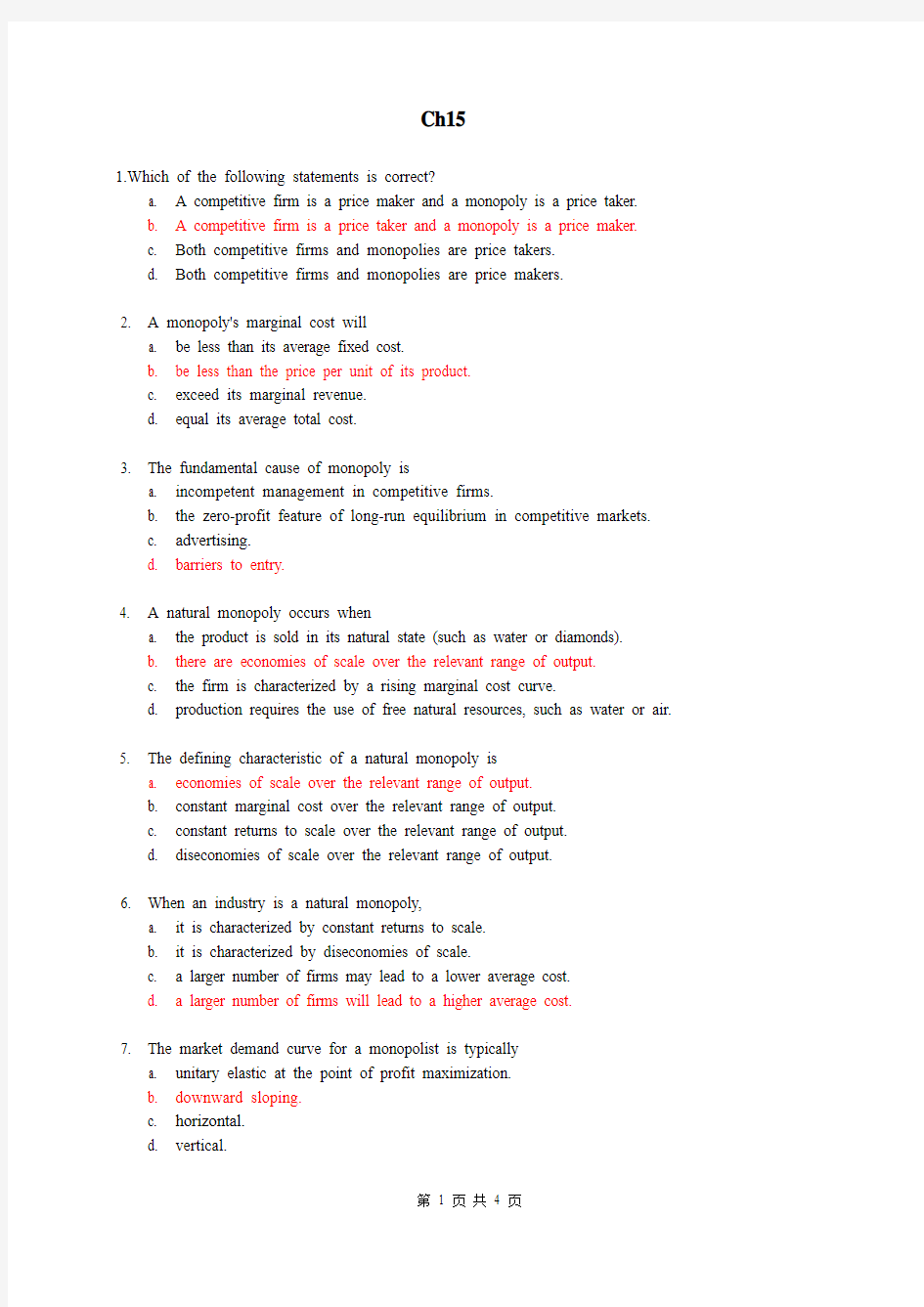

Ch15
1.Which of the following statements is correct?
a. A competitive firm is a price maker and a monopoly is a price taker.
b. A competitive firm is a price taker and a monopoly is a price maker.
c. Both competitive firms and monopolies are price takers.
d. Both competitive firms and monopolies are price makers.
2. A monopoly's marginal cost will
a. be less than its average fixed cost.
b. be less than the price per unit of its product.
c. exceed its marginal revenue.
d. equal its average total cost.
3. The fundamental cause of monopoly is
a. incompetent management in competitive firms.
b. the zero-profit feature of long-run equilibrium in competitive markets.
c. advertising.
d. barriers to entry.
4. A natural monopoly occurs when
a. the product is sold in its natural state (such as water or diamonds).
b. there are economies of scale over the relevant range of output.
c. the firm is characterized by a rising marginal cost curve.
d. production requires the use of free natural resources, such as water or air.
5. The defining characteristic of a natural monopoly is
a. economies of scale over the relevant range of output.
b. constant marginal cost over the relevant range of output.
c. constant returns to scale over the relevant range of output.
d. diseconomies of scale over the relevant range of output.
6. When an industry is a natural monopoly,
a. it is characterized by constant returns to scale.
b. it is characterized by diseconomies of scale.
c. a larger number of firms may lead to a lower average cost.
d. a larger number of firms will lead to a higher average cost.
7. The market demand curve for a monopolist is typically
a. unitary elastic at the point of profit maximization.
b. downward sloping.
c. horizontal.
d. vertical.
8. If a profit-maximizing monopolist faces a downward-sloping market demand curve, its
a. average revenue is less than the price of the product.
b. average revenue is less than marginal revenue.
c. marginal revenue is less than the price of the product.
d. marginal revenue is greater than the price of the product.
9. A profit-maximizing monopolist will produce the level of output at which
a. average revenue is equal to average total cost.
b. average revenue is equal to marginal cost.
c. marginal revenue is equal to marginal cost.
d. total revenue is equal to opportunity cost.
10. For a profit-maximizing monopolist,
a. P > MR = MC.
b. P = MR = MC.
c. P > MR > MC.
d. MR < MC < P.
11. Which of the following is an impossible feat for a monopolist to accomplish?
a. control the price of its good
b. charge a higher price and continue to sell the same quantity
c. operate at a point on the upper half of the demand curve
d. All of the above are correct.
12. Marginal revenue can become negative for
a. both competitive and monopoly firms.
b. competitive firms, but not for monopoly firms.
c. monopoly firms, but not for competitive firms.
d. neither competitive nor monopoly firms.
The figure below reflects the cost and revenue structure for a monopoly firm. Use it to answer the following questions.
Figure 15-2
13. Refer to Figure 15-2. If the monopoly firm wants to maximize its profit, it should operate at
a level of output equal to
a. Q1.
b. Q2.
c. Q3.
d. Q4.
14. Refer to Figure 15-2. Profit will be maximized by charging a price equal to
a. P0.
b. P1.
c. P2.
d. P3.
15. The monopolist's profit-maximizing quantity of output is determined by the intersection of
which of the following two curves?
a. marginal cost and demand
b. marginal cost and marginal revenue
c. average total cost and marginal revenue
d. average variable cost and average revenue
16. A monopolist will choose to increase output when
a. market price increases.
b. at all levels of output, marginal cost increases.
c. at the present level of output, marginal revenue exceeds marginal cost.
d. All of the above are correct.
17. What is the monopolist's profit under the following conditions? The profit-maximizing price
charged for goods produced is $12. The intersection of the marginal revenue and marginal cost curves occurs where output is 10 units, marginal cost is $8, and average total cost is $7.
a. Not enough information is given to determine the answer.
b. $10
c. $40
d. $50
18. When a monopolist is able to sell its product at different prices, it is engaging in
a. distribution pricing.
b. quality adjusted pricing.
c. price differentiation.
d. price discrimination.
19. The practice of selling the same goods to different customers at different prices, but with the
same marginal cost, is known as
a. price segregation.
b. price discrimination.
c. arbitrage.
d. monopoly pricing.
20. In theory, perfect price discrimination
a. decreases the monopolist's profits.
b. decreases consumer surplus.
c. increases deadweight loss.
d. All of the above are correct.
21. A firm cannot price discriminate if it
a. has perfect information about consumer demand.
b. operates in a competitive market.
c. faces a downward-sloping demand curve.
d. is regulated by the government.